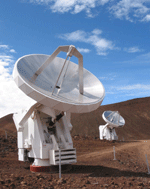Introduction
 The Submillimeter Array (SMA), constructed at the top of Mauna Kea in Hawaii as a collaborative project of the Smithsonian Astrophysical Observatory (SAO) and the Academia Sinica Institute of Astronomy & Astrophysics (ASIAA), is the first radio interferometer making observations at submillimeter wavelengths. A total of eight 6-m radio telescopes comprise the array with currently working receiver bands at 230, 345, 400 and 690 GHz. The array covers the frequency range of 180-700 GHz. The backend is flexible analog-digital correlator with a full bandwidth of 2GHz, which is very powerful to cover several line emissions simultaneously. The SMA can achieve an angular resolution of 0.1 arcsec at highest, providing at least 60 times sharper images than those the existing submillimeter-wave single-dish telescopes can provide. It can be arranged into configurations with baselines as long as 509 m, allowing us to observe submillimeter emission from warm, dense gas and dust at unprecedented high resolutions of up to 0.1 arcsecond. Using the SMA, we study how stars and planets form, how stars evolve, the center of our Galaxy and nearby galaxies, what is the looks of the early universe, and so on.
The Submillimeter Array (SMA), constructed at the top of Mauna Kea in Hawaii as a collaborative project of the Smithsonian Astrophysical Observatory (SAO) and the Academia Sinica Institute of Astronomy & Astrophysics (ASIAA), is the first radio interferometer making observations at submillimeter wavelengths. A total of eight 6-m radio telescopes comprise the array with currently working receiver bands at 230, 345, 400 and 690 GHz. The array covers the frequency range of 180-700 GHz. The backend is flexible analog-digital correlator with a full bandwidth of 2GHz, which is very powerful to cover several line emissions simultaneously. The SMA can achieve an angular resolution of 0.1 arcsec at highest, providing at least 60 times sharper images than those the existing submillimeter-wave single-dish telescopes can provide. It can be arranged into configurations with baselines as long as 509 m, allowing us to observe submillimeter emission from warm, dense gas and dust at unprecedented high resolutions of up to 0.1 arcsecond. Using the SMA, we study how stars and planets form, how stars evolve, the center of our Galaxy and nearby galaxies, what is the looks of the early universe, and so on.
The SMA project in Taiwan
The SMA Project was originally conceived at the SAO in 1983. While the initial concept for the SMA was six 6~m antennas, in 1996, the ASIAA joined the SMA project by agreeing to add two more antennas and all the associated electronics, including a doubling of the correlator and additional receiver systems. The Academia Sinica founded the expansion of the SMA as the first astronomical project at the ASIAA. The additional two antennas increase the number of instantaneous baselines from 15 to 28, nearly doubling the mapping speed of the array.
It is the first time for the ASIAA to construct submillimeter telescopes and receivers. A key for the institute to construct two antennas in Taiwan was to find expertise at industries. The Aeronautical Research Laboratory (ARL) was selected as a general contractor for the antenna construction because of their considerable experiences in high-precision assembly of jet airplanes. The mounts that support the antennas were constructed at the China Shipping Building Corporation (CSBC) because of its experiences in manufacturing and handling large metal parts for ships. Carbon fiber reinforced plastic tubes for the backup structures supporting the reflecting surface of each antenna were manufactured by NYTEX (currently GIGAN TEX), one of Taiwanese leading composites manufacture. In fact, tubes made in Taiwan are so good yet economical that they were also used in all the antennas constructed by the SAO.
In order to develop and deliver receiver systems for two additional antennas, the ASIAA has established a laboratory for submillimeter receivers. In addition, the ASIAA has started collaborations with National Tsinghua University in Taiwan, Nobeyama Radio Observatory in Japan, and the Purple Mountain Observatory in China to produce SIS junctions for the SMA receiver system.
By the end of 2003, all eight antennas of the array had been deployed on the top of Mauna Kea, and the SMA was formally dedicated on 2003 November 22. More details of the SMA are found in Ho, Moran, & Lo (2004).
History
- 1996 Jun
- Academia Sinica signed the Agreement for Collaboration concerning SMA with the Smithsonian Institution.
- 2000 Dec
- The first antenna from Taiwan (SMA Antenna 7) test @ ARL finished and shipped to Mauna Kea
- 2001 Feb
- Antenna 7 assembling started at Mauna Kea
- 2001 May
- Antenna 7 assembling completed
- 2001 Jun
- The second antenna from Taiwan (SMA Antenna 8) test @ ARL finished and shipped to Mauna Kea
- 2001 Aug
- Antenna 8 assembling started at Mauna Kea
- 2002 Dec
- Antenna 8 assembling completed
- 2003 Nov
- Dedication of SMA
- 2004
- Science operation started


